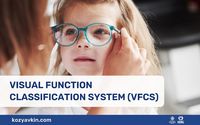The assessment of the functional abilities of the patients with cerebral palsy (CP) is necessary for the choice of proper treatment and assessment of its results, and also for the choice of strategies and means of adaptation.
Many tools and classifications with proven validity and reliability have been developed to assess the level of development and capabilities of patients with cerebral palsy. These include the Gross Motor Function Classification System (GMFCS), the Manual Ability Classification System (MACS), and the ABILHANDS-Kids questionnaire for the assessment of hand function.
Children with CP often have impaired vision and visual dysfunction caused either by brain injury (cerebral vision impairment) or injury of the eye structures (for example retinopathy of prematurity, cataracts). People with CP have a high prevalence of eye problems and may require the use of glasses.
Visual Function Classification Scale (VFCS) is a tool aimed at the classification of the visual functions that assesses Activity and Participation domains of the International Classification of Functioning, Disability and Health (ICF).
It was developed by the research group from the Stella Maris Research Institute (Piza, Italy) lead by Giovanni Baranello. The goal of the team that developed the VFCS was to include vision into the system of existing classifications for people with CP.
The System was validated with children aged 1-19. You can read an article about VFCS from its developers here.
Visual Function Classification Scale (VFCS) is a valid and reliable 5-level classification system that describes how children with cerebral palsy (CP) use visual functions in daily life.
The System is focused on activity and participation and takes into account these domains of the ICF. It is helpful for harmonization of communication between professionals, as well as planning means of support and adaptation for the child.
The VFCS does not explain the underlying reasons for the visual function abilities. It highlights functional abilities rather than limitations.
The VFCS describes the usual daily performance of a person with CP rather than his or her best capacity. That is why it is important to think about daily situations in typical environment when classifying the level of visual function by System. The lowest level corresponds to better functioning.
The classification could be completed by any person who is familiar with the child's visual function abilities, including a parent or caregiver, physician or physical therapist, or the individual themselves.
You can learn more about the VFCS and download it by the link.

